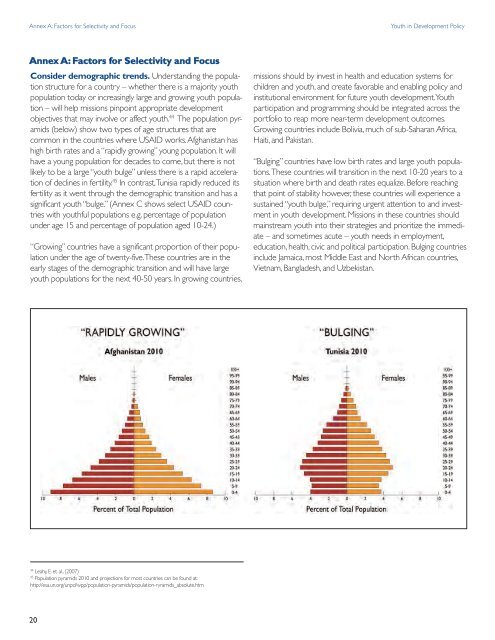YOUTH IN DEVELOPMENT Realizing the Demographic Opportunity USAID POLICY YOUTH
YOUTH IN DEVELOPMENT Realizing the Demographic Opportunity USAID POLICY YOUTH
YOUTH IN DEVELOPMENT Realizing the Demographic Opportunity USAID POLICY YOUTH
You also want an ePaper? Increase the reach of your titles
YUMPU automatically turns print PDFs into web optimized ePapers that Google loves.
Annex A: Factors for Selectivity and Focus Youth in Development Policy<br />
Annex A: Factors for Selectivity and Focus<br />
Consider demographic trends. Understanding <strong>the</strong> population<br />
structure for a country – whe<strong>the</strong>r <strong>the</strong>re is a majority youth<br />
population today or increasingly large and growing youth population<br />
– will help missions pinpoint appropriate development<br />
objectives that may involve or affect youth. 44 The population pyramids<br />
(below) show two types of age structures that are<br />
common in <strong>the</strong> countries where <strong>USAID</strong> works.Afghanistan has<br />
high birth rates and a “rapidly growing” young population. It will<br />
have a young population for decades to come, but <strong>the</strong>re is not<br />
likely to be a large “youth bulge” unless <strong>the</strong>re is a rapid acceleration<br />
of declines in fertility. 45 In contrast,Tunisia rapidly reduced its<br />
fertility as it went through <strong>the</strong> demographic transition and has a<br />
significant youth “bulge.” (Annex C shows select <strong>USAID</strong> countries<br />
with youthful populations e.g. percentage of population<br />
under age 15 and percentage of population aged 1024.)<br />
“Growing” countries have a significant proportion of <strong>the</strong>ir population<br />
under <strong>the</strong> age of twentyfive.These countries are in <strong>the</strong><br />
early stages of <strong>the</strong> demographic transition and will have large<br />
youth populations for <strong>the</strong> next 4050 years. In growing countries,<br />
44 Leahy, E. et. al., (2007)<br />
45 Population pyramids 2010 and projections for most countries can be found at:<br />
http://esa.un.org/unpd/wpp/populationpyramids/populationryramids_absolute.htm<br />
‘<br />
20<br />
missions should by invest in health and education systems for<br />
children and youth, and create favorable and enabling policy and<br />
institutional environment for future youth development.Youth<br />
participation and programming should be integrated across <strong>the</strong><br />
portfolio to reap more nearterm development outcomes.<br />
Growing countries include Bolivia, much of subSaharan Africa,<br />
Haiti, and Pakistan.<br />
“Bulging” countries have low birth rates and large youth populations.These<br />
countries will transition in <strong>the</strong> next 1020 years to a<br />
situation where birth and death rates equalize. Before reaching<br />
that point of stability however, <strong>the</strong>se countries will experience a<br />
sustained “youth bulge,” requiring urgent attention to and investment<br />
in youth development. Missions in <strong>the</strong>se countries should<br />
mainstream youth into <strong>the</strong>ir strategies and prioritize <strong>the</strong> immediate<br />
– and sometimes acute – youth needs in employment,<br />
education, health, civic and political participation. Bulging countries<br />
include Jamaica, most Middle East and North African countries,<br />
Vietnam, Bangladesh, and Uzbekistan.


